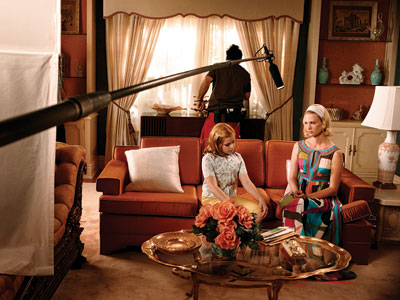Difference between revisions of "JCM312/Sound"
From Screenpedia
Jump to navigationJump to search (Created with text from FILM ART) |
(updated) |
||
| (18 intermediate revisions by 2 users not shown) | |||
| Line 1: | Line 1: | ||
| − | + | '''Sound perspective''' | |
| − | + | #What is ''sound perspective'' in film? | |
| − | # | + | #*[http://tvcrit.com/find/uglybetty ''Ugly Betty'' example of sound perspective mismatch.] |
| − | + | #What are the different types of microphone pick-up patterns? How do they affect sound perspective? E.g., how would you describe the likely sound perspective of the ''Mad Men'' scene below? | |
| − | # | + | <gallery mode="packed" heights=200px> |
| − | + | File:Mad-Men-January-on-set l.jpg | |
| − | + | </gallery> | |
| − | # | ||
| − | |||
| − | |||
| − | |||
| − | + | '''Sound and time''' | |
| − | # | + | #The time frame of a narrative scene's sound need not match the time frame of its image. |
| − | # | + | #*How is time manipulated in these [http://tvcrit.com/find/damages ''Damages''] and [https://vimeo.com/345041314 ''Traffic''] scenes? |
| + | |||
| + | '''Diegetic and nondiegetic sound''' | ||
| + | #What is a ''diegesis''? | ||
| + | #*What is diegetic sound? Nondiegetic sound? Examples? | ||
| + | |||
| + | '''Sound technology''' | ||
| + | #What are the three main types of sound in film and TV production and how do digital audio workstations mirror those three types? ([http://tvcrit.com/find/protools See ''Ugly Betty'' ProTools layout for music editor.]) | ||
| + | #Explain these terms in the context of digital audio: sampling, dynamic range, and frequency response. | ||
| + | |||
| + | '''Sound-image interaction exercise''' | ||
| + | |||
| + | What does ''Television'''s exercise (using a [http://tvcrit.com/find/audioexperiment 1957 Dodge commercial]) illustrate? | ||
| + | #As a group, choose a well-known song that, if laid over the commercial, would change its meaning. (No R-rated songs, please.) We'll find an excerpt of it online and lay it over the commercial. Be prepared to explain to the class how your song changes the commercial's meaning. | ||
==External links== | ==External links== | ||
| − | + | *[https://tvcrit.org/Classes/Jbutler/TVCrit2018_images_ByChapters/11/ ''Television'', sound chapter illustrations] | |
| − | + | *[https://vimeo.com/345098436 Dodge commercial] or [http://criticalcommons.org/Members/jbutler/clips/dodge1957commercial_originalaudio.mp4/view Critical Commons version] | |
| − | + | *[http://tvcrit.com/find/damages ''Damages'' sound-time manipulation] | |
| − | + | *[https://tvcrit.org/Classes/Jbutler/T340/ClassicismIllustrations01.htm Classical Hollywood sound examples] | |
| + | *[https://tvcrit.org/EO/DV/FilmArt/index02.htm ''Film Art'' examples] | ||
| + | **[https://vimeo.com/345041314 ''Traffic'' example] | ||
| + | **[https://tvcrit.org/EO/DV/ManEscaped.htm ''A Man Escaped'' example] | ||
| + | |||
| + | == Bibliography == | ||
| + | #Jeremy G. Butler, ''Television: Visual Storytelling and Screen Culture'' (New York: Routledge, 2018). | ||
| + | #David Bordwell and Kristin Thompson, ''Film Art: An Introduction'', (New York: McGraw-Hill). | ||
| − | [[Category: | + | [[Category:JCM312 Discussion]] |
Latest revision as of 19:05, 4 September 2019
Sound perspective
- What is sound perspective in film?
- What are the different types of microphone pick-up patterns? How do they affect sound perspective? E.g., how would you describe the likely sound perspective of the Mad Men scene below?
Sound and time
- The time frame of a narrative scene's sound need not match the time frame of its image.
Diegetic and nondiegetic sound
- What is a diegesis?
- What is diegetic sound? Nondiegetic sound? Examples?
Sound technology
- What are the three main types of sound in film and TV production and how do digital audio workstations mirror those three types? (See Ugly Betty ProTools layout for music editor.)
- Explain these terms in the context of digital audio: sampling, dynamic range, and frequency response.
Sound-image interaction exercise
What does Television's exercise (using a 1957 Dodge commercial) illustrate?
- As a group, choose a well-known song that, if laid over the commercial, would change its meaning. (No R-rated songs, please.) We'll find an excerpt of it online and lay it over the commercial. Be prepared to explain to the class how your song changes the commercial's meaning.
External links
- Television, sound chapter illustrations
- Dodge commercial or Critical Commons version
- Damages sound-time manipulation
- Classical Hollywood sound examples
- Film Art examples
Bibliography
- Jeremy G. Butler, Television: Visual Storytelling and Screen Culture (New York: Routledge, 2018).
- David Bordwell and Kristin Thompson, Film Art: An Introduction, (New York: McGraw-Hill).
